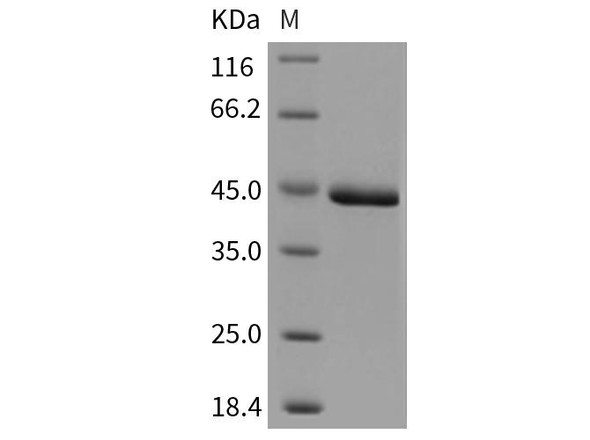Description
| Product Name: | Mouse CHI3L1/YKL40 Recombinant Protein (His tag) |
| Product Code: | RPES5738 |
| Size: | 20µg |
| Species: | Mouse |
| Expression Host: | E.coli |
| Synonyms: | AW208766, Brp39, Gp39, YKL-40, YKL40,YYL-40, hCGP-39 |
| Mol Mass: | 39.49 kDa |
| AP Mol Mass: | 42 kDa |
| Tag: | N-His |
| Purity: | > 95 % as determined by reducing SDS-PAGE. |
| Endotoxin Level: | Please contact us for more information. |
| Bio Activity: | Testing in progress |
| Sequence: | Tyr 30-Ala 389 |
| Accession: | Q61362 |
| Storage: | Generally, lyophilized proteins are stable for up to 12 months when stored at -20 to -80°C. Reconstituted protein solution can be stored at 4-8°C for 2-7 days. Aliquots of reconstituted samples are stable at < -20°C for 3 months. |
| Shipping: | This product is provided as lyophilized powder which is shipped with ice packs. |
| Formulation: | Lyophilized from sterile PBS, pH 7.4. Normally 5 % - 8 % trehalose, mannitol and 0.01% Tween80 are added as protectants before lyophilization. Please refer to the specific buffer information in the printed manual. |
| Reconstitution: | Please refer to the printed manual for detailed information. |
| Background: | Chitinase-3-like protein 1 (CHI3L1) is a secreted heparin-binding glycoprotein whose expression is associated with vascular smooth muscle cell migration. CHI3L1 is expressed at high levels in postconfluent nodular VSMC cultures and at low levels in subconfluent proliferating cultures. CHI3L1 is a tissue-restricted, chitin-binding lectin and member of glycosyl hydrolase family 18. In contrast to many other monocyto / macrophage markers, its expression is absent in monocytes and strong induced during late stages of human macrophage differentiation. Elevated levels of CHI3L1 are associated with disorders exhibiting increased connective tissue turnover, such as rheum atoid, arthritis, osteoarthritis, scleroderma, and cirrhosis of liver, but is produced in cartilage from old donors or patiens with osteoarthritis. CHI3L1 is abnormally expressed in the hippocampus of subjects with schizophrenia and may be involved in the cellular response to various environmental events that are reported to increase the risk of schizophrenia. |






